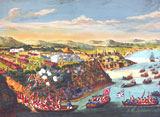|
|
|
|
|
|
|
|
|
Battle for Canada Montcalm and Wolfe on the Plains of Abraham Battle for Canada
British route from Halifax to
Quebec, 1759
(Canadian War Museum, 1.D.2.1-CGR2) 
Scale Model of the Battle of the
Plains of Abraham, Canadian War Museum
Photo: Steven Darby, CMC 
Scale Model
of the Battle of the Plains of Abraham, Canadian War Museum
Illustration by Malcolm Jones, 2005 
A View of the Taking of
Quebec
September 13th, 1759 Courtesy of Library and Archives Canada, C-139911 Quebec City was the only place where the French could lose and the British could win the Seven Years' War in North America. A successful defence of Canada depended upon the arrival of supplies and reinforcements from Europe, carried up the St. Lawrence River. If the British captured the city, they could cut the supply lines between Canada and France. The French in Canada would be forced to surrender. In June 1759, the Royal Navy carried a powerful British army to Quebec. On the verge of defeat after an unsuccessful three-month siege, British troops landed west of Quebec on 13 September 1759. An army of French regulars, Canadian militia, and First Peoples warriors met them in battle on the Plains of Abraham. The British won, following a 30-minute clash of arms. Quebec City surrendered five days later. Montcalm and Wolfe on the Plains of AbrahamThis model depicts the Battle of the Plains of Abraham at about 10:20 a.m. on 13 September 1759. British regulars are red, French regulars grey-white, Canadian militia blue, and First Peoples warriors brown.
Mistakes that Made History
A. Wolfe's Mistake: Taking the Low Ground
B. Montcalm's Mistake: Abandoning the High Ground
C. The French Charge
D. The British Volleys |
|||||||||||||||||||||||||||||||||||||||||||||||||||||||||||||||||||||||||||||||||||||||
